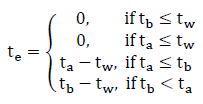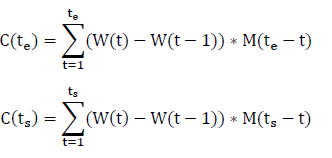Computational Procedure (Life Loss)
The computation of life loss resulting from a flood event assumes a structure inventory has been generated (Direct Damage); the depth and flood arrival time at each structure has been determined (Hydraulic Event Computation); and that the population has been distributed (Population Distribution).
For a flood event, a warning is issued at a user-defined time, tw. Based on hydraulic data, HEC-FIA then calculates the time when a structure becomes inundated (more than two feet), defined as ta. The time when depth arrives at the structure's safe location, is defined as tb. From these three times, HEC-FIA can calculate the amount of time available for evacuation, defined as te as shown in the equation below:

For a safe evacuation, HEC-FIA either uses the evacuation time specified by the user or calculates the amount of time required for the people to evacuate to a safe location after they have mobilized, defined as Et. HEC-FIA calculates Et using the equation below:
Et = d/s
where:
d is the distance to the nearest safe location from the structure
s is the user-defined nominal evacuation velocity
HEC-FIA then calculates an additional relevant time, the amount of time available for a successful evacuation, defined as ts in the equation below:
t_s = t_e - E_t
Given the total available evacuation time and the amount of time available for a successful evacuation, HEC-FIA calculates three evacuation outcome categories using the combined warning and mobilization curve equation above, and using te and ts :

The percentage of population in the zone who evacuated to a safe location, Cleared is defined in the equation below:
| Cleared = C(t_s) |
The percentage of population in the zone who are caught evacuating, Caught is defined in the equation below:
| Caught = C(t_e) - C(t_s) |
The percentage of population in the zone that remained in a structure, Not Mobilized, is calculated using the equation below:
| Not Mobilized = 1 - C(t_e) |
The next step in the process is to sort the Not Mobilized population into vertical lethality zones by structure type. The population in structures are assigned to flood lethality zones based on maximum depth of flooding over the entire flood event and the occupancy type of the structure. For example, it is assumed that the population over the age of 65, will not be able to access the roof of a structure, and thus this population lethality zone thresholds (i.e., heights) are lower by default in HEC-FIA. Lethality zone thresholds can be modified for each occupancy type.
The modifications can be made for each zone's start threshold, for over and under the age of 65. For example, this need may occur for a senior living facility, as special accommodations for the population over the age of 65 may have been provided easy access to the roof of the structure. Illustrations of the flood lethality zones for one- and two-story structures are displayed in the previous section.
The general methodology of the lethality rate assignment for population under 65 residing in a one-story structure in the Not Mobilized category is described in the following steps. Using HEC-FIA default values for the lethality zone thresholds, for each additional story, nine feet is added to the depth criteria below to determine the flood lethality zone.
- If maximum depth is less than Foundation Height (FH) plus 13 feet, then assign the population to the Safe Flood Zone.
- If the maximum depth is greater than or equal to FH plus 13 feet and less than the FH plus 15 feet, then assign the population to Compromised Flood Zone.
- Else event maximum depth greater than or equal to FH plus 15 feet, then assign the population to Chance Flood Zone.
The exception to the above criteria is that if the depth-times-velocity exceeds specified maximums, the structure is either considered to be partially or totally damaged, and the population of the structure is assigned to either the Compromised or Chance flood zones, regardless of the maximum depth of flow occurring at the structure. The depth-times-velocity criteria used in HEC-FIA for different structure types is displayed in the table below.
Structure Type: Depth-Times-Velocity Damage Criteria
Structure | Partial Damage | Total Damage |
Unanchored Wood Framed | d*v ≥ 21.5 ft2/s | d*v ≥ 32.3 ft2/s |
Anchored Wood Framed | d*v ≥ 32.3 ft2/s | d*v ≥ 75.3 ft2/s |
Masonry, Concrete, | v ≥ 6.6 ft/s AND | v ≥ 6.6 ft/s AND |
If the user is computing without uncertainty, the average fatality rates from HEC-FIA Fatality Rates for Evacuation Outcome Categories Table are used for each flood lethality zone. If the user is computing with uncertainty, the fatality rate distributions in the Flood Zone Empirical Distributions Figure are used for each flood lethality zone (McClelland and Bowels, 2002). Three uniform random numbers are drawn for each structure (one for each zone), the inverse of the empirical distribution is called, and the resulting fatality rate is utilized as displayed in the Flood Zone Empirical Distribution Figure.
The loss of life for each structure is calculated by multiplying the remaining population in the structure by the appropriate fatality rate. The Population At Risk (PAR) value is computed by determining the number of people in structures that get wet, i.e., structures at which depths are greater than zero feet, for day and night.